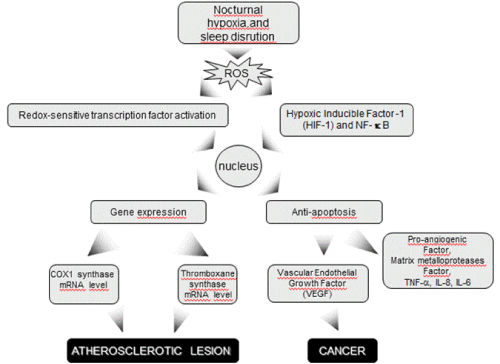Journal of Sleep Disorders & Therapy
Open Access
ISSN: 2167-0277
ISSN: 2167-0277
Clinical image - (2015) Volume 4, Issue 2

The obstructive sleep apnea syndrome (OSA) is an independent risk factor for atherosclerosis. Chronic intermittent hypoxia (CHI) causes atherosclerosis in the occurrence of a pre-existing hyperlipidemia. A new pathway, in animal models, has been demonstrated that CIH significantly increased atherosclerotic lesion sizes, mRNA levels of COX-1 and thromboxane synthase (TXBS). Lesion size is correlated to COX-1 and TXBS mRNA levels. COX-1 inhibition reduced lesion progression in intermittent hypoxia mice. This study has demonstrated, for the first time, that the activation of the COX pathway exposed to CIH is associated with increased atherosclerotic lesions in mice, highlighting early atherosclerosis markers in OSA patients [1,2].
CIH and sleep disruption are responsible of pathophysiological pathways determining a systemic disease. In fact, OSA has been associated with diseases with a high inflammatory potential, such as psoriasis and other autoimmune disorders. The potential mechanisms involved in the cancer development progression from hypoxia have been investigated. It has been shown, that CIH can regulate different stages of cell differentiation and proliferation in animal models. The cellular hypoxia, present in cancer, and the adaptive response is geared to a family of transcription factors, the most significant being hypoxia-inducible factor (HIF)-1.
HIF-1 activates the transcription of genes which play a fundamental role in angiogenesis and genetic modification, with the formation of cancer-related stem cells. The prevalence of HIF-1 has been associated with a considerable increase in reactive oxygen species (ROS) generated during periods of hypoxia/reoxygenation, which may play an important role in modifying gene expression by regulating the activity of some transcription factors. These include activator protein-1, which may play a key role in carcinogenesis, with the development of cancer through the induction of apoptotic inhibitory factors, matrix metallo-proteases and pro-angiogenic factors of which the most important is probably vascular endothelial growth factor (VEGF) [3].